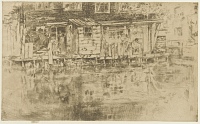Etchings Institutions search term: grolier club
The Long House (The Dyers, Amsterdam) | ||
| Number: | 453 | |
| Date: | 1889 | |
| Medium: | etching and drypoint | |
| Size: | 166 x 271 mm | |
| Signed: | butterfly to upper left of centre | |
| Inscribed: | no | |
| Set/Publication: | no | |
| No. of States: | 6 | |
| Known impressions: | 14 | |
| Catalogues: | K.406; M.408; W.266 | |
| Impressions taken from this plate (14) | ||
KEYWORD
TITLE
'(The Dyers). Long houses.' (1890, Whistler). 1
'The Dyers (Longs House[)]' (1890, Whistler). 2
'Long Houses. (The Dyers)' (1890, Whistler). 3
'Long House The Dyers ' (1890/1891, Whistler). 4
'Long House' (1890, Whistler). 5
'"The Long House" (The Dyers Amsterdam)' (1890, Whistler). 6
'"Long house" [Amsterdam] ' (1890/1892, Beatrice Whistler (1857-1896)). 7
'The Long House' (1893, World's Columbian Expo.). 8
'Long House - Dyer's - Amsterdam' (1899, Frederick Wedmore (1844-1921)). 9
'The Long House Dyer's Amsterdam' (1903/1935, possibly Rosalind Birnie Philip (1873-1958)). 10
'Long House, Amsterdam' (1909, Howard Mansfield (1849-1938)). 11
'Long-House – Dyer’s – Amsterdam' (1910, Edward Guthrie Kennedy (1849-1932)). 12
There are several problems in identifying the correct title, the first being that at first Whistler emphasized 'The Dyers', and later, the 'Long House' or 'Long Houses.' The next problem is that his original title reflects the fact that there is more than one 'Long house'.
The third problem is that the punctuation varies even more than usual, with definitive articles, quotation marks, brackets and dashes, each of which alters the emphasis of the title. It is impossible to resolve all these variations.
'The Long House (The Dyers, Amsterdam)' is based on the title Whistler gave to South Kensington Museum, which might be considered definitive.
1: Whistler to Dunthorne, 17 February 1890, GUW #13039.
2: To H. Mansfield, 4 March 1890, GUW #13047.
3: To C. L. Freer, 4 March 1890, GUW #13065.
4: List, [1890/1891], GUW #13236.
5: To Wunderlich's, 29 May 1890, GUW #13058.
6: To South Kensington Museum, 2 July 1890, GUW #13044.
7: List, [1890/1892], GUW #12715.
8: Chicago 1893 (cat. no. 2266 [1685]).
9: Wedmore 1899 (cat. no. 266).
10: Envelope containing copper plate, University of Glasgow.
11: Mansfield 1909 (cat. no. 408).
12: Kennedy 1910 (cat. no. 406).
DESCRIPTION
SITE
13: Heijbroek 1997 , pp. 65-66.
DISCUSSION
